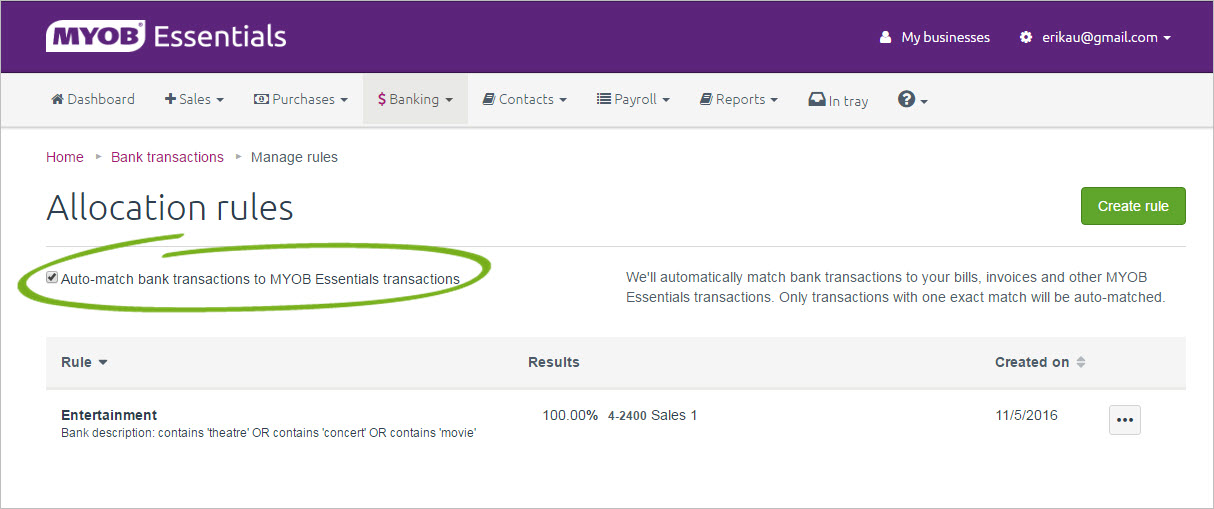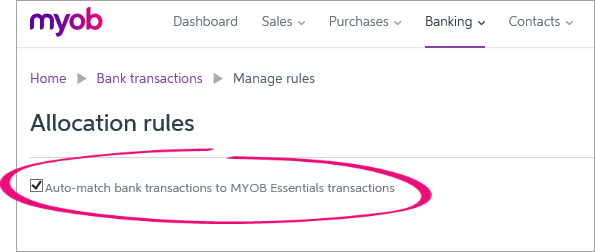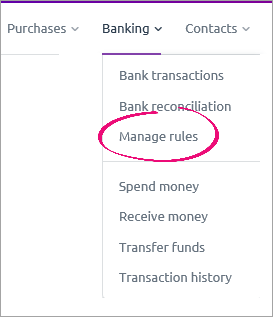Create, edit or delete your allocation rules from Manage rules - found under the Banking dropdown.  Image Removed Image Removed
You can choose whether to allow You use rules in MYOB Essentials to automatically match your transactions, and you can set up rules to automatically allocate the transactions that appear on your bank feed.Transactions that are auto-matched or automatically or allocate transactions that come in via bank feeds or imported bank statements. Once you've created a rule, you can edit or delete it. Transactions that are automatically matched or allocated based on your rules will appear in the Bank transactions page with a magic wand  Image Added icon next to them. Image Added icon next to them.  Image Removed Image Removed Image Added Image Added
If a match or allocation is wrong, you can unmatch or unallocate the transaction. See Allocating bank transactions and Matching bank transactions. Auto-matchingBy default, MYOB Essentials will auto-match a transaction if there's one exact match available. You might want to turn this off if you've got a lot of transactions for the same amount, or if you find transactions are often incorrectly auto-matched. If you don't want transactions to be auto-matched, you can deselect the Auto-match bank transactions to MYOB Essentials transactions option from the Manage Allocation rules page.  Image Removed Image Removed Image Added Image Added
If auto-matching is turned off, transactions with one match will show on the Bank transactions page as having 1 match available and you'll need to manually confirm the match yourself. See Matching bank transactions. Allocation rulesIf you regularly receive certain transactions, you can set up an allocation rule. MYOB Essentials will use these rules to allocate the amounts of all imported bank transactions that meet the criteria to the nominated MYOB Essentials account. You can set up a rule using any unique description or amount (or multiple descriptions or amounts) in the bank transactions you import into MYOB Essentials. When the same type of transaction always uses the same text or amount, you can use it to automatically allocate the transaction to the correct MYOB Essentials account. Banks provide only brief descriptions for transactions, but they usually contain enough information to identify the relevant MYOB Essentials account. Allocation rules won’t cover all transactions, but they save significant time once you’ve set them up. They will apply every time you import new bank transactions, but you can edit or delete them at any time. Make sure the description text is suitableTo make sure the description text of a bank transaction is suitable to be used as an allocation rule, check that: - the same text appears regularly in transactions,
- the text is unique, and
- if the text is long, it can be shortened easily and still refer to all items belonging to a certain account.
Editing and deleting allocation rulesTo edit and delete allocation rules, access the Allocation rules page by clicking the Banking menu, then click Manage rules.  Image Added Image Added
| UI Expand |
|---|
| title | To create an allocation rule from a bank transaction |
|---|
| Go to the Banking menu and choose Bank transactions. The Bank transactions page appears, showing your bank transactions from your bank feed or imported bank statements.
If you're using the new banking:Find the bank transaction you'd like to base your allocation rule on and click the down arrow in the right column to expand the transaction.Click the Create rule tab.Edit the description in the If your bank transaction description contains field so that it will match all transactions you want this rule to apply to. This field is not case-sensitive.
For example, if the field says "POS 0392342-BUNNINGS NUNAWADING VI", you might change it to simply say "BUNNINGS".In the and the amount is field, choose whether you want the rule to apply to all transactions matching this description, or only those with the same amount as the transaction you're basing the rule on. This can be useful if, for example, your regular phone and internet bills are from the same company, but for different amounts.In the allocate the transaction by field, choose whether you want to split the allocation by percentage or by dollar amount.
If you're not splitting the transaction between more than one account, choose percentage.In the Percentage or Amount field, enter the percentage or amount you want to allocate to the first account. If you're allocating the whole amount to one account, leave this value as 100% or Full amount.In the Account field, choose which account you want to allocate this amount to. The Tax code field is filled in automatically, but you can change it if you want.If you're splitting the transaction between more than one account, enter the percentage or amount in the next line and choose the account and tax code.Repeat step h until the full amount has been accounted for.Click Save. The rule is created and applied to any unallocated or unmatched transactions.
If you're using the old banking:Find the bank transaction you'd like to base your allocation rule on and click the transaction description. The Deposit details or Withdrawal details window appears. Click Create rule. The Create Allocation Rule window appears. If you can't see this window, try scrolling down the page. - Edit the description in the If your bank transaction description contains field so that it will match all transactions you want this rule to apply to. This field is not case-sensitive.
For example, if the field says "POS 0392342-BUNNINGS NUNAWADING VI", you might change it to simply say "BUNNINGS". - In the and the amount is field, choose whether you want the rule to apply to all transactions matching this description, or only those with the same amount as the transaction you're basing the rule on. This can be useful if, for example, your regular phone and internet bills are from the same company, but for different amounts.
- In the allocate the transaction by field, choose whether you want to split the allocation by percentage or by dollar amount.
If you're not splitting the transaction between more than one account, choose percentage. - In the Percentage or Amount field, enter the percentage or amount you want to allocate to the first account. If you're allocating the whole amount to one account, leave this value as 100% or Full amount.
- In the Account field, choose which account you want to allocate this amount to. The Tax rate field is filled in automatically, but you can change it if you want.
- If you're splitting the transaction between more than one account, enter the percentage or amount in the next line and choose the account and tax code.
- Repeat step h until the full amount has been accounted for.
Click Save. The rule is created and applied to any unallocated or unmatched transactions.
| UI Expand |
|---|
| title | To create allocation rules |
|---|
| You don't need to base your allocation rules on the transactions that have already appeared in your bank feed or bank statement. If you already know the transactions you'll be allocating, just go to the Manage allocation rules page and set up your rules there. Go to the Banking menu and chooseManage allocation rules.Click Create allocation rule. The Create Allocation Rule window appears. If you can't see this window, try scrolling further down the page. Complete the fields at the top of the Create Allocation Rule window. In the first field, enter the text that you want to use to allocate transactions.
Note that if you’re creating an allocation rule while you’re allocating a transaction to a MYOB Essentials account, this field will contain the transaction’s Description text. If necessary, edit the text. | UI Text Box |
|---|
| Case-sensitivity The text you enter here will not be treated as case-sensitive. |
- From the first drop-down list, select whether you want to allocate transactions with amounts equal to the amount you’ll choose in step c, or allocate transactions of any amount.
- If you chose equal to in step b, enter an amount in the field that becomes active. Only transactions with amounts equal to this amount will be allocated.
- From the second drop-down list, select whether you want to allocate transaction amounts by dollar amount, or percentage.
In the Account column of the list, select the MYOB Essentials account that you want to allocate transaction amounts to.If you want to split transaction amounts between two or more MYOB Essentials accounts:- Click Split Amount or Split Percentage (note that this button name changes according to the option you chose in step d of step 3).
A new line appears in the list. - Select a second MYOB Essentials account and amount or percentage.
- Repeat for any other accounts you want to split transaction amounts between.
- Enter an Amount or Percentage against the first account, with the balance against the other accounts (note that this column name changes according to the option you chose in step d of step 3).
Click Save to save the allocation rule.| UI Expand |
|---|
| title | To edit allocation rules |
|---|
| Go to the Banking menu and chooseManage allocation rules. The Allocation Rules page appears, displaying details of all existing allocation rules in the list.Click the allocation rule you want to edit. The Edit allocation | To edit allocation rules| UI Text Box |
|---|
| Editing a rule won't change previously matched or allocated transactions. |
From the Banking menu, choose Manage rules. The Allocation rules page appears. | UI Text Box |
|---|
| Click the Rule column to sort rules and help you find the rule you want to edit. |
- Click the ellipsis button
 Image Added for the allocation rule you want to edit and choose Edit. Image Added for the allocation rule you want to edit and choose Edit. - The Edit rule window appears, displaying details of the allocation rule.
- Make any your changes.
- Click Save to save your changes.. If automatching has been turned on, the edited rule will be automatically matched to unallocated transactions that meet the rule's conditions.
|
| UI Expand |
|---|
| title | To delete allocation rules |
|---|
| Go to To delete allocation rules| UI Text Box |
|---|
| Deleting a rule won't change previously matched or allocated transactions. |
- From the Banking menu and , choose Manage allocation rules. The The Allocation Rules page appears, displaying details of all existing allocation rules in the list.Select the rules page appears.
- Click the ellipsis button
 Image Added for the allocation rule you want to delete and click choose Delete. A confirmation message appears. Image Added for the allocation rule you want to delete and click choose Delete. A confirmation message appears. - Click Yes to Delete rule to delete the allocation rule.
|
|